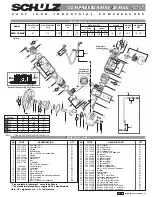
98 of 132
M-SV-001-EN Rev.E
Icon
Tool
Description
Compressor Configuration
View and configure the compressor operation, shutdown configuration, IGV startup,
communication configuration, surge/choke, and other operational configuration parameters.
Compressor
Commissioning
View, modify and commit site-specific compressor parameter values of a connected
compressor, as well as import and export configurations between portable files. Minor
guidance is provided to the user by presenting any number of configuration pages which are
necessary for consideration during the deployment of a compressor system.
Compressor Data Trending
Graphically monitor selected compressor parameter values and load or save user-configurable
watch configurations.
Table 21- Service Monitoring
Tools Icons (Continued)
Troubleshooting
4.2.1 Compressor Fault
Troubleshooting
When troubleshooting a compressor fault,
detailed analysis of this data should be made (in
conjunction with a Yenta compressor recording
file, if possible) to determine the specific fault and
determine the root cause of fault occurrence.
Downloading fault and event logs every time a
compressor is visited is useful for documenting
compressor operational history.
Fault and event history can be extracted from
the compressor memory in the
SMT Logged
Event and Fault Viewer
tool. See the latest
Service Monitoring Tools User Manual for user
instructions.
Active compressor fault and alarm messages can
be viewed in the
SMT Active Alarm/Fault Viewer
tool. See the latest Service Monitoring Tools User
Manual for user instructions.
Compressor Alarm and Fault settings can be
found in the
Configure Alarms/Faults
menu option
of the
Active Alarm/Fault Viewer tool.
The
Compressor Data Recording and Playback
tool provides a method of reviewing operational
conditions without a connection to the
compressor. It also creates a file to electronically
transmit for peer review. See the latest
Service Monitoring Tools User Manual for use
instructions.
The following principle is applied when having
both a fault and/or an alarm limit as triggers. In
the following explanations for faults and alarms,
the trigger method terminology is used: Instant
fault triggering (INS), Ascending Fault Triggering
(AFT), Descending Fault Triggering (DFT) and
Range Fault Triggering (RFT).
Summary of Contents for Turbocor TT-300
Page 2: ...THIS PAGE INTENTIONALLY LEFT BLANK...
Page 4: ...4 of 132 M SV 001 EN Rev E THIS PAGE INTENTIONALLY LEFT BLANK...
Page 12: ...12 of 132 M SV 001 EN Rev E THIS PAGE INTENTIONALLY LEFT BLANK...
Page 61: ...61 of 132 M SV 001 EN Rev E Compressor Components Figure 56 Stator Thermistor R T Curve 1...
Page 120: ...120 of 132 M SV 001 EN Rev E THIS PAGE INTENTIONALLY LEFT BLANK...
Page 130: ...130 of 132 M SV 001 EN Rev E Notes...
















































